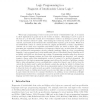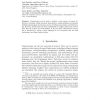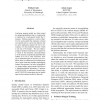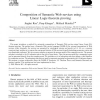11066 search results - page 9 / 2214 » Linearity in Process Languages |
AAAI
2004
13 years 8 months ago
2004
Representing lexicons and sentences with the subsymbolic approach (using techniques such as Self Organizing Map (SOM) or Artificial Neural Network (ANN)) is a relatively new but i...
LICS
1991
IEEE
13 years 10 months ago
1991
IEEE
When logic programming is based on the proof theory of intuitionistic logic, it is natural to allow implications in goals and in the bodies of clauses. Attempting to prove a goal ...
LISP
2002
13 years 6 months ago
2002
Abstract. Continuations can be used to explain a wide variety of control behaviours, including calling/returning (procedures), raising/handling (exceptions), labelled jumping (goto...
EMNLP
2011
12 years 6 months ago
2011
Log-linear parsing models are often trained by optimizing likelihood, but we would prefer to optimise for a task-specific metric like Fmeasure. Softmax-margin is a convex objecti...
IS
2006
13 years 7 months ago
2006
This paper introduces a method for automatic composition of Semantic Web services using Linear Logic (LL) theorem proving. The method uses a Semantic Web service language (DAML-S)...




